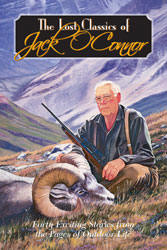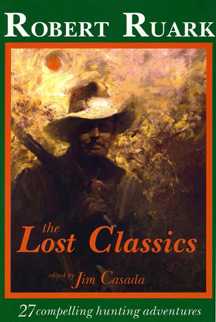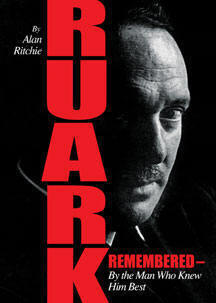Jim Casada Outdoors January 2014
Newsletter
|
| Jim Casada 1250 Yorkdale Drive Rock Hill, SC 29730-7638 803-329-4354 |
Web site:
www.jimcasadaoutdoors.com |
Click here to view this newsletter in a .pdf with a white background for easy printing.
Sidelights on Dreamin’ and Schemin’My Grandpa Joe figures in these newsletters or a fairly regular basis. That’s a testament to how much time he spent with me when I was a boy and how much I loved that grizzled, soft-spoken old man of the mountains. It took me many years to realize it, but in my own Smoky Mountain way I was just as blessed as a famous outdoor writer, Robert Ruark, who turned his relationship with his grandfather (actually both of them, because his books The Old Man and the Boy and The Old Man’s Boy Grows Older really feature a figure who was a composite of his grandfathers). In my studied opinion his books are the finest ever written on the outdoors in this country, and below you’ll find more information on Ruark in “This Month’s Author.” But for now the subject is my grandfather, and what a joy he was. This time of year we spent a lot of time nestled up close to the fire in the living room, fortified by having put away a bait of some of Grandma Minnie’s fine cooking. Size-wise Grandpa was a small man, wiry and tough as a well-season hickory sprout, but his appetite belied his size. He was a trencherman of the first magnitude, and while some of his approaches to food and drink may have been a bit strange, they always made good sense. He wanted his coffee or tea so hot it would scald, and if it was a tad too hot he would just “sasser” it (pour some out into the saucer holding his cup) to cool. He loved his vegetables—turnip greens, cooked turnips, green beans, soup beans, stewed tomatoes, and the like—but what he loved best was when the vegetables of the day got to the bottom of the bowl leaving nothing but tidbits and pot liquor. He would crumble in cornbread or biscuit until the leavings got just right then spoon it up while smacking his lips. I now know that he was getting the very best of the vitamins with the pot liquor. He was also a great one for self-medicating. His approach in this regard ran towards prevention; he believed that if you ate “hearty” you stayed healthy. He always ended grace at the family table with the same words: “You’uns see what’s before ye; eat hearty.” One of Grandpa’s favorites, particularly this time of year, was what he called “pepper tea.” Grandpa would raise hot peppers so fiery just touching one to your lips would set you on fire, and woe be unto anyone who handled them then forgot and rubbed their eyes. They were in for a serious ration of misery, and I speak from first-hand experience. In late summer he would dry those peppers in the simplest of ways—pulling up the whole plant and hanging it upside down beneath a tin roof. Nothing in the way of insects bothered them, and the peppers would keep right through the winter. He made pepper tea by taking two or three of the dry pods, parching them a bit in the oven under low heat, then crumbling the pods and seeds up. He would tie a spoonful or so of this in cheese cloth and steep it in hot water just as you would make regular tea. The result was hotter than the hinges of Hades, but Grandpa would drink it, smack his lips even as sweat beaded on his brow, and mutter, “my, that’s fine.” Often while he sipped his pepper tea Grandpa would indulge in what he liked to call “dreamin’ and schemin’.” That involved dreaming of trips past as well as ones yet to come and scheming on how to get prepared, exactly what excuses we were going to offer Grandma Minnie (and my parents) to gain permission for planned outings, and generally relishing the whole ritual of preparation. That in turn would likely devolve into his sharing a tale or two from his stock of stories. How I wish I had recorded his account of killing a cougar when he was a young man (I have no doubt whatsoever it happened, because there were still a few mountain lions, as Grandpa styled them, left in the Smokies at the turn of the 20th century). Similarly, I never tired of hearing him tell about the time it snowed so hard, so suddenly, and so deep, that rabbits were trapped and you could locate them by holes in the snow with steam coming out. He and some friends caught a tow sack full of cottontails. To borrow from the title of a book by one of my favorite writers, “Those Were the Days.” Incidentally, that writer was Archibald Rutledge, and in recent weeks most of my personal “dreamin’ and schemin’” has focused on work on my long-planned biography of the man known as Old Flintlock. Many of you have already asked to be notified when the book appears, but I would also note that I have already edited and compiled a number of anthologies of Rutledge’s work, and I have a lengthy list of books by and about him for sale. You can find them on my Web site, or just drop me an e-mail, and I’ll send you the Word file. If you want to be added to the “to notify” list for the biography, just use the same e-mail contact. |
Jim’s Doings I’m writing this while the SHOT Show, a big trade event I used to attend every year, is in progress. I no longer go, having become increasingly “sot in my ways,” detesting air travel, and have little use for that earthly hellhole, Las Vegas, where the event is held. I’ll compensate to some extent by attending the National Wild Turkey Federation’s annual convention in Nashville the middle of next month. Nashville’s much more my kind of place, and I’ve got a world of treasured friends in the expansive turkey family. If you plan to be there and I have a book you want or something you’d like to chat about, let me know by e-mail, and we can pick a time and place to meet. I’ll even wear a watch to keep track of time, although that’s something I don’t ordinarily do. Incidentally, I’m one of those dinosaurs who doesn’t own a cell phone (and I don’t want to be tied to one of those technological umbilical cords), so don’t suggest contact in that fashion. Prior to that event, I’ll be down in the Black Belt of Alabama taking part in a Cast & Blast event sponsored by a number of good friends in the industry. It will involve hunting for ducks and deer (the rut in Alabama actually takes place in January) and fishing for bass. I’ll try to remember to give you a full report in the February newsletter. Sandwiched between these two events will be a truly special weekend for me. On February 7 and 8 there will be various ceremonies held at Winthrop University in connection with inductions into the university’s Athletic Hall of Fame. Thanks to having started the institution’s soccer program and having served as head coach for the sport during its first dozen years, along with having had a significant role in getting youth soccer launched in the community, I’m to be among the inductees. It will be a chance to see some of my players from yesteryear, revel in a special moment with family and friends, and look back with pleasure at the way in which some fine young men have gone on to be contributors to their communities, achieve success on a variety of fronts, have families of their own, and generally, as mountain folks put it, “do me proud.” Soccer is not longer an active part of my life, but for many years as a college and semi-pro player, prep school and the college coach, and national-level referee, it was important to me. |
Love Those Leather Britches
For those of you who don’t recognize the term “leather britches,” first let me extend my sympathy and then hasten to add that you’ve had a life of culinary deprivation. Fortunately, that is easy enough to change. Leather britches are dried green beans, and in the days before canning, and later, freezers, became commonplace in the mountains as ways to store and preserve food, much of it was dried. Examples would be apples and peaches, and really hardworking folks sometimes made plum or persimmon leather as well (the dried pulp of those fruits). Dried beans, especially October beans, were a staple of diet.
But green beans (there are various mountain names to describe them according to their nature and means of growth—runner beans, half-runners, bush beans, creasy beans, and the like) were also dried. Properly done and then suitably stored, the result, “leather britches,” would last right through the winter. The process of drying was the essence of simplicity. In our family we just strung the beans (not taking the time to break them) and then threaded the result, one pod after another, on strong pieces of string. This was done with the aid of a heavy-duty sewing needle. You just ran the needle through a bean the way you would start out to sew a stitch, pushed the bean down the thread out of the way, and moved on to the next pod. Once you had a long stringer of beans, several hundred of them, they were ready for drying.
This was accomplished by putting them out in the hot summer sun, often atop a tin roof, beneath the rafters of a barn loft, or in the attic of a home. The idea was to get the moisture removed as quickly as possible and have the pods shrivel and dry to the point where they were withered and readily broke apart with application of any pressure. Most folks preferred doing the drying beneath a roof. It wasn’t quite as quick as when the beans were atop a tin roof right out in the sun, but with that approach you had to wait until the sun was out, keep close watch for threatening rain, and get them in before the first hint of evening dew.
Whatever approach was taken, once full dried leather britches were a cinch to store. You just hung them in some out of the way place, such as high up on rafters in the kitchen, to await use. When it came to cooking them, preparing a big pot of leather britches was the essence of simplicity. They were placed in a big pot with plenty of water and a chunk or two of streaked meat for seasoning and set to simmering. Slow cooked in this fashion for a few hours they would reconstitute as they absorbed moisture and become tender and tasty in the process. All that was required was the occasional check to be sure there was plenty of water in the pot (they soaked up an amazing amount of it) and seasoning to taste at the end. Salt and a bit of black or red pepper did the trick, and alongside a fine pone of cornbread they were a dish to stick to the ribs. I can’t describe the taste other than to say it is distinctively different from fresh green beans. Try it and you’ll find that this old-time mountain dish is a pure delight, and I for one like harkening back to the food customs of my forebears.
News on the Book Front
The book did wonderfully well, with the deluxe limited edition selling out almost immediately and the trade edition soon being gone as well. Finally it is back in print, and since many of you had inquired about its availability, I am happy to announce that I can once more offer signed, inscribed copies of the handsome 359-page hardback book, with lovely art work by Dan Burr and a center section of 33 original photograph (many of them in color) for $35 +$5 shipping and handling. You can order by sending a check c/o Jim Casada, 1250 Yorkdale Drive, Rock Hill, SC 29730 or via PayPal by clicking the button below. |
Recent Reading The vast majority of my reading in recent weeks has concentrated on the writings of Archibald Rutledge. As I dig through box after box of notes, photocopies, original letters, clippings, and the like, I’ve also been endeavoring to re-read all his books. Sometimes the poetry is a bit of a grind for me, although on other occasions I think his verse is wonderful. With Rutledge’s prose, however, whether it is the hunting stories for which he is today best known or some of his little inspirational works, there’s never any doubt. It’s always pure delight. If you haven’t read works such as Home by the River, An American Hunter, Days Off in Dixie, The World Around Hampton, Peace in the Heart, Life’s Extras, Hunter’s Choice, and many more (he wrote 59 published books in all), a treat awaits you. |
This Month’s Author
Robert Ruark (1915-1965) ranks, in my studied opinion, second to none in terms of his contributions to sporting literature. Two of his books, The Old Man and the Boy and The Old Man’s Boy Grows Older, are irresistible classics. Anyone who grew up hunting and fishing instantly identifies with their tales of adventures shared by a youngster and his grandfather on the North Carolina coast in the area of Southport. They are filled with wit, whimsy, and wisdom. I can’t give any better indication of their appeal than to share something a fellow who called the other day to talk about the value of a book collection (I do appraisals of sporting libraries from time to time) shared with me. “When I die,” he said, “my daughter has specific instructions. Put a copy of The Old Man and the Boy in my hands and then have me cremated. Scatter my ashes and those from the book on some of the places I’ve fished and hunted all my life.”
If perchance you haven’t read Ruark, the “Old Man” tales each stand on their own. They originally appeared as an immensely popular column in Field & Stream magazine before being collected to form the two books. Years ago, as a lifelong student of Ruark and his writing, I discovered that a fair number of the “Old Man” tales did not make it into either of the books. That gave me an idea and formed the basis for a book I edited and compiled, The Lost Classics of Robert Ruark. Comprised of stories which had never before appeared in book form, it includes ten “Old Man” pieces, material he wrote on Hemingway, tales from hunts in Africa, and more. The book is available from me for $35 plus $5 shipping. Publication of that book, which was very well received, led in turn to my being asked to edit a biography of Ruark written by his longtime secretary, Alan Ritchie. The resulting work, Ruark Remembered, delves into what was a wonderfully fascinating but also terribly troubled life in deep and insightful fashion. I also have that book in stock – $40 plus $5 shipping.
|
The Lost Classics of Robert Ruark, $35 plus $5 |
Ruark Remembered, $40 plus $5 shipping. |
Ruark wrote another grand book on the outdoors, Horn of the Hunter. To my way of thinking, it is a far finer treatment of sport in Africa than anything Hemingway did. Then there were some blockbuster novels, including Something of Value, Poor No More, Uhuru, and others. Ruark was a writing machine, churning out thousands of newspaper columns on top of everything else, and it is enduringly sad that he died short of his 50th birthday. He in effect committed suicide, not with a gun in the way of Hemingway (Ruark was widely known as “The Poor Man’s Hemingway”) but through crawling inside a bottle and falling captive to the destructive powers of demon rum. In many ways he was a miserable individual, but at his best no one has ever written on the outdoors the way he did. I have a lengthy list of books by or about Ruark on my Web site or e-mail me and I’ll send a Word file.
Thank you for subscribing to the
Jim Casada Outdoors
newsletter.
Feel free to contact Jim with your comments, questions
or suggestions at jc@jimcasadaoutdoors.com.
Send mail to
webmaster@jimcasadaoutdoors.com with
questions or comments about this Web site.
Copyright © 2004-2011 JimCasadaOutdoors.com. Last modified:
01/16/14 .
Web site design by
Wordman, LLC

 Almost a decade ago I completed my work on the book which would become
The Lost Classics of Jack O’Connor and sent it off to press. My
efforts consisted of choosing the forgotten O’Connor stories to include
in the book (one criteria was that they had not been published in any of
the books he wrote during his lifetime), arranging them suitably,
providing a substantial biographical introduction to the work, and
completing it with a bibliographical essay dealing with printed material
by or about the great gun writer.
Almost a decade ago I completed my work on the book which would become
The Lost Classics of Jack O’Connor and sent it off to press. My
efforts consisted of choosing the forgotten O’Connor stories to include
in the book (one criteria was that they had not been published in any of
the books he wrote during his lifetime), arranging them suitably,
providing a substantial biographical introduction to the work, and
completing it with a bibliographical essay dealing with printed material
by or about the great gun writer. 
